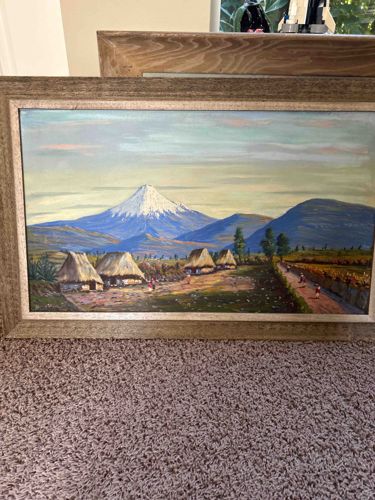
Mountain Landscape with Village and Thatched Huts
This is a landscape painting, likely an oil on canvas or board, depicting a vibrant rural scene with a prominent, snow-capped mountain in the background. The foreground features a cluster of traditional, thatched-roof huts (possibly adobe or mud brick construction), suggesting a village or settlement. A dirt path or road extends from the middle ground towards the right, with several small figures, likely people, walking or working along it. To the right of the path, there appears to be a cultivated field, possibly of grains or crops, indicated by the warm, golden hues. The sky transitions from light blues and yellows near the horizon to deeper teals and grays overhead, suggesting either dawn, dusk, or an overcast day. In the mid-ground, there are rolling hills or smaller mountains leading up to the large peak, rendered in shades of blue and purple, indicating distance and atmospheric perspective. Green foliage, including what appear to be agaves or similar desert plants, is visible in the immediate foreground on the left. The overall color palette is bright and somewhat idealized, characteristic of tourist art or regional landscape painting. The brushwork appears to be relatively loose and expressive, giving a sense of texture to the landscape elements and the thatched roofs. There are no immediately visible signs of significant damage like tears, punctures, or major paint loss, but the image quality makes it difficult to assess minor abrasions or craquelure. The painting is housed in a simple, possibly wooden, frame with a slightly distressed or natural finish. The 'came from Africa' context seems inconsistent with the visual cues, as the landscape strongly resembles volcanic regions and traditional rural villages found in Central or South America, particularly the Andes or regions like Mexico, given the architectural style and vegetation. The craftsmanship appears competent, suggesting a trained but not necessarily master artist, possibly from the mid-20th century to late 20th century.
AI-Generated Appraisal Disclaimer
Estimated Value
$150-300
Basic Information
Category
Painting
Appraised On
December 7, 2025
Estimated Value
$150-300
Additional Details Provided By Owner
User Provided Information
Came from Africa
Item Description
This is a landscape painting, likely an oil on canvas or board, depicting a vibrant rural scene with a prominent, snow-capped mountain in the background. The foreground features a cluster of traditional, thatched-roof huts (possibly adobe or mud brick construction), suggesting a village or settlement. A dirt path or road extends from the middle ground towards the right, with several small figures, likely people, walking or working along it. To the right of the path, there appears to be a cultivated field, possibly of grains or crops, indicated by the warm, golden hues. The sky transitions from light blues and yellows near the horizon to deeper teals and grays overhead, suggesting either dawn, dusk, or an overcast day. In the mid-ground, there are rolling hills or smaller mountains leading up to the large peak, rendered in shades of blue and purple, indicating distance and atmospheric perspective. Green foliage, including what appear to be agaves or similar desert plants, is visible in the immediate foreground on the left. The overall color palette is bright and somewhat idealized, characteristic of tourist art or regional landscape painting. The brushwork appears to be relatively loose and expressive, giving a sense of texture to the landscape elements and the thatched roofs. There are no immediately visible signs of significant damage like tears, punctures, or major paint loss, but the image quality makes it difficult to assess minor abrasions or craquelure. The painting is housed in a simple, possibly wooden, frame with a slightly distressed or natural finish. The 'came from Africa' context seems inconsistent with the visual cues, as the landscape strongly resembles volcanic regions and traditional rural villages found in Central or South America, particularly the Andes or regions like Mexico, given the architectural style and vegetation. The craftsmanship appears competent, suggesting a trained but not necessarily master artist, possibly from the mid-20th century to late 20th century.
Related Tags
Explore similar items and categories:
Get Your Items Appraised
Instant estimates of your treasures with AI-powered instant appraisals